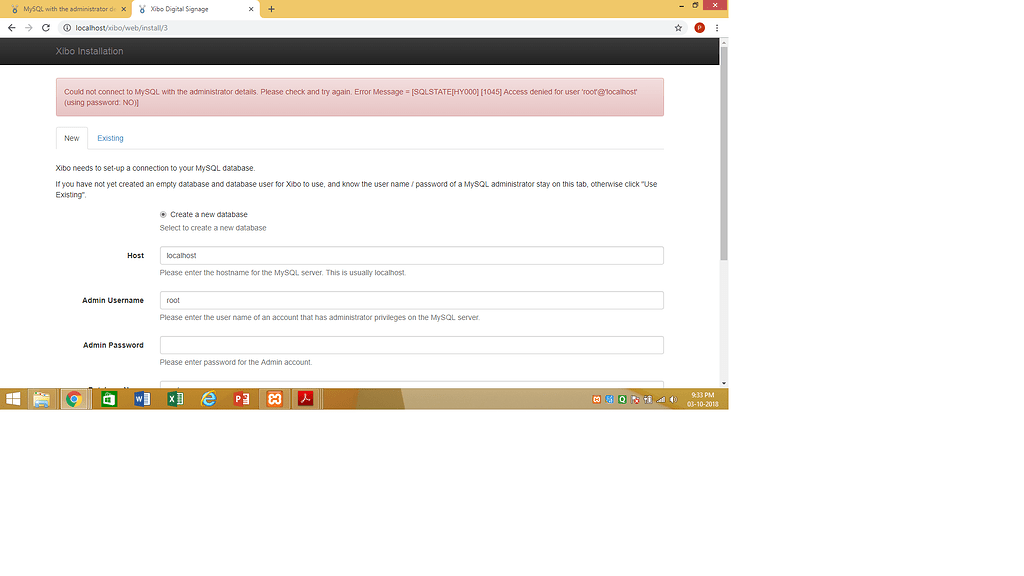
- #Phpmyadmin root password error root@localhost how to#
- #Phpmyadmin root password error root@localhost install#
- #Phpmyadmin root password error root@localhost password#
- #Phpmyadmin root password error root@localhost windows#
This will launch a file browser in the XAMPP folder. The Explorer button in the XAMPP Control Panel.
#Phpmyadmin root password error root@localhost password#
It involves opening up a text file and editing the password directly in it.įirst, open the XAMPP Control Panel and click on the Explorer button on the right-hand side of the window: If you find yourself in a situation where you know your password is correct, but it isn’t working for whatever reason, this is the method for you.

Change Your XAMPP MySQL Password by Editing the File When you’re finished, you can click on the Go button in the bottom-right to save the change. On the next screen, simply enter the password you want to use: Next, you can click on Edit privileges beside the root user, then select Change password at the top of the page. Next, navigate to the User accounts section in the main menu bar, and locate the root user for localhost in the list: If you haven’t set one yet, you can leave it blank.

If you’re asked to log in, use the username “root” and enter your root password. PhpMyAdmin will open in a browser window: Join 20,000+ others who get our weekly newsletter with insider WordPress tips! Want to know how we increased our traffic over 1000%? Pull up the XAMPP Control Panel and click on Admin in the MySQL row: This technique is relatively simple, but generally not as quick as the command line method.įirst, you need to access the phpMyAdmin interface. The second method involves using the phpMyAdmin GUI to change your XAMPP MySQL password. Change Your XAMPP MySQL Password via phpMyAdmin Once you’ve done that, you’re finished and can close the shell window. Press Enter/Return again, and you’ll be asked to confirm the new password. The shell will prompt you to enter a new password. Enter the following command and press the Enter/Return key: mysqladmin -u root password This will open up a new window with a command prompt.

Use the XAMPP shell to change your root password. To get started, launch your XAMPP Control Panel and click on the Shell button on the right-hand side. Since this is a unique shell specific to XAMPP, any typical differences between the platforms won’t apply.
#Phpmyadmin root password error root@localhost windows#
Note that these commands are the same whether you’re using Windows or macOS. This is also the method you’ll want to use if you’ve forgotten your existing MySQL password and need to reset it. However, it’s actually fairly straightforward. It does involve using the command line, which can seem daunting at first. Using the XAMPP shell is generally going to be the simplest and quickest method for changing your MySQL password. Change Your MySQL Password Using the XAMPP Shell With that in mind, let’s take a look at three ways to change your MySQL password in XAMPP.

The method you should use will depend on exactly what you need to do and what interface you’re most comfortable with: the command line, a Graphical User Interface (GUI), or text files.
#Phpmyadmin root password error root@localhost how to#
Learn more about DevKinsta! How to Change Your MySQL Password in XAMPP (3 Methods)Īs with most WordPress tasks, there are multiple ways to change the MySQL password. Looking for a powerful tool for local WordPress development? DevKinsta features one-click site creation, built-in HTTPS, powerful email and database management tools, and more. Whatever the reason, being able to change MySQL passwords is a valuable skill that could come in handy. Regularly changing passwords can help offset issues that might arise without this practice.įinally, you may have simply forgotten your password and, as a result, can’t access files or functions that you need on your local XAMPP WordPress installation. Doing so helps prevent malicious activity, particularly if you use the same password in multiple places. Anyone could log in to the user account and edit files on your local installation.Īpart from that, it’s also a smart security practice to change your passwords periodically. As such, having no password protection for this user is a major security hole. The root user is essentially the administrator account-it has unrestricted access to all commands and files in the system. This means that there is no security on this account by default.
#Phpmyadmin root password error root@localhost install#
First and most important: when you install XAMPP on your computer, the password for the “root” user is left empty. There are several reasons why you might want (or need) to change your MySQL password. Why You Might Want to Change Your MySQL Password


 0 kommentar(er)
0 kommentar(er)
